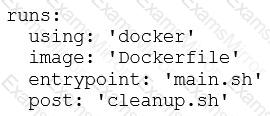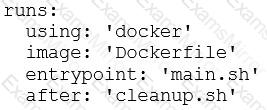Big Halloween Sale Limited Time 70% Discount Offer - Ends in 0d 00h 00m 00s - Coupon code = simple70
Pass the GitHub Certification GitHub-Actions Questions and answers with ExamsMirror
Exam GitHub-Actions Premium Access
View all detail and faqs for the GitHub-Actions exam
441 Students Passed
86% Average Score
94% Same Questions
Which of the following statements are true regarding the use of GitHub Actions on a GitHub Enterprise Server instance? (Choose three.)
You are a developer working on developing reusable workflows for your organization. What keyword should be included as part of the reusable workflow event triggers?
GitHub-hosted runners support which capabilities? (Choose two.)
You installed specific software on a Linux self-hosted runner. You have users with workflows that need to be able to select the runner based on the identified custom software. Which steps should you perform to prepare the runner and your users to run these workflows? (Choose two.)
In which scenarios could the GITHUB_TOKEN be used? (Choose two.)
Which default GitHub environment variable indicates the owner and repository name?
As a developer, you need to create a custom action written in Python. Which action type should you choose?
As a developer, you need to create a custom action written in Python. Which action type should you choose?
Which statement is true about using default environment variables?
How can GitHub Actions encrypted secrets be used in if: conditionals within a workflow job?
As a DevOps engineer, you are developing a container action. You need to execute a cleanup script after completing the main script execution. Which code block should be used to define the cleanup script?
TOP CODES
Top selling exam codes in the certification world, popular, in demand and updated to help you pass on the first try.




